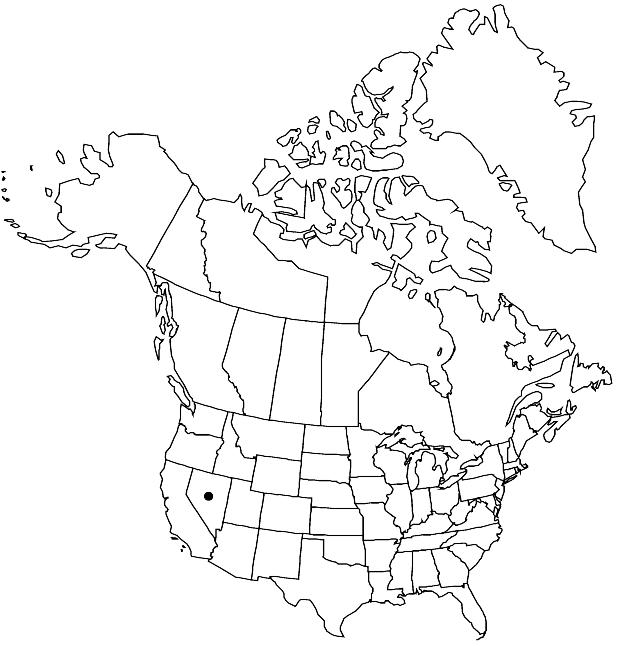Difference between revisions of "Boechera falcifructa"
Novon 13: 385. 2003.
FNA>Volume Importer |
imported>Volume Importer |
||
| (6 intermediate revisions by 2 users not shown) | |||
| Line 7: | Line 7: | ||
|year=2003 | |year=2003 | ||
}} | }} | ||
| − | |basionyms={{Treatment/ID/ | + | |basionyms={{Treatment/ID/Basionym |
|name=Arabis falcifructa | |name=Arabis falcifructa | ||
|authority=Rollins | |authority=Rollins | ||
| + | |rank=species | ||
| + | |publication_title=Contr. Gray Herb. | ||
| + | |publication_place=212: 112. 1982 | ||
}} | }} | ||
|synonyms= | |synonyms= | ||
| Line 27: | Line 30: | ||
|distribution=Nev. | |distribution=Nev. | ||
|discussion=<p>Of conservation concern.</p><!-- | |discussion=<p>Of conservation concern.</p><!-- | ||
| − | --><p>Morphological evidence suggests that Boechera falcifructa is an apomictic species that arose through hybridization between B. cobrensis and B. fernaldiana. It is more similar to the former, but is distinguished by its gently curved fruiting pedicels (versus strongly recurved or reflexed distally), narrower (1.2–1.5 versus 1.7–2.5 mm) fruits, more (62–80 versus 34–64) ovules per ovary, longer (0.5–1 versus 0.05–0.2 mm) styles, and narrower (0.05–0.1 versus 0.25–0.5 mm) seed wings. Although independently reproducing, B. falcifructa is known only from Elko and Lander counties, where the parental species grow in proximity.</p> | + | --><p>Morphological evidence suggests that <i>Boechera falcifructa</i> is an apomictic species that arose through hybridization between <i>B. cobrensis</i> and <i>B. fernaldiana</i>. It is more similar to the former, but is distinguished by its gently curved fruiting pedicels (versus strongly recurved or reflexed distally), narrower (1.2–1.5 versus 1.7–2.5 mm) fruits, more (62–80 versus 34–64) ovules per ovary, longer (0.5–1 versus 0.05–0.2 mm) styles, and narrower (0.05–0.1 versus 0.25–0.5 mm) seed wings. Although independently reproducing, <i>B. falcifructa</i> is known only from Elko and Lander counties, where the parental species grow in proximity.</p> |
|tables= | |tables= | ||
|references= | |references= | ||
| Line 36: | Line 39: | ||
-->{{#Taxon: | -->{{#Taxon: | ||
name=Boechera falcifructa | name=Boechera falcifructa | ||
| − | |||
|authority=(Rollins) Al-Shehbaz | |authority=(Rollins) Al-Shehbaz | ||
|rank=species | |rank=species | ||
| Line 51: | Line 53: | ||
|publication year=2003 | |publication year=2003 | ||
|special status= | |special status= | ||
| − | |source xml=https:// | + | |source xml=https://bitbucket.org/aafc-mbb/fna-data-curation/src/2e0870ddd59836b60bcf96646a41e87ea5a5943a/coarse_grained_fna_xml/V7/V7_521.xml |
|tribe=Brassicaceae tribe Boechereae | |tribe=Brassicaceae tribe Boechereae | ||
|genus=Boechera | |genus=Boechera | ||
Latest revision as of 23:34, 5 November 2020
Perennials; usually long-lived; apomictic; caudex often woody. Stems usually 1 per caudex branch, arising from center of rosette near ground surface, 1.5–4.5 dm, densely pubescent proximally, trichomes short-stalked, 4–9-rayed, 0.05–0.2 mm, glabrous or sparsely pubescent distally. Basal leaves: blade linear to narrowly oblanceolate, 1–4 mm wide, margins entire, ciliate at petiole base, trichomes (simple), to 0.5 mm, surfaces densely pubescent, trichomes short-stalked, 4–9-rayed, 0.05–0.2 mm. Cauline leaves: 5–9, not concealing stem; blade auricles 0.5–1 mm, surfaces of distalmost leaves sparsely pubescent. Racemes 10–18-flowered, sparingly branched. Fruiting pedicels divaricate-descending, gently curved downward, 6–12 mm, pubescent, trichomes appressed, branched. Flowers divaricate-ascending at anthesis; sepals pubescent; petals lavender, 5–7 × 0.7–1.2 mm, glabrous; pollen spheroid. Fruits divaricate-descending, not appressed to rachis, not secund, gently curved, edges parallel, 4.5–6 cm × 1.2–1.5 mm; valves glabrous; ovules 62–80 per ovary; style 0.5–1 mm. Seeds uniseriate, 1.2–1.7 × 0.8–1.2 mm; wing mostly distal, 0.05–0.1 mm wide.
Phenology: Flowering May–Jun.
Habitat: Rocky slopes and sandy soil in sagebrush or pinyon-juniper woodlands
Elevation: 1500-1800 m
Discussion
Of conservation concern.
Morphological evidence suggests that Boechera falcifructa is an apomictic species that arose through hybridization between B. cobrensis and B. fernaldiana. It is more similar to the former, but is distinguished by its gently curved fruiting pedicels (versus strongly recurved or reflexed distally), narrower (1.2–1.5 versus 1.7–2.5 mm) fruits, more (62–80 versus 34–64) ovules per ovary, longer (0.5–1 versus 0.05–0.2 mm) styles, and narrower (0.05–0.1 versus 0.25–0.5 mm) seed wings. Although independently reproducing, B. falcifructa is known only from Elko and Lander counties, where the parental species grow in proximity.
Selected References
None.
